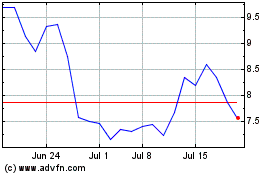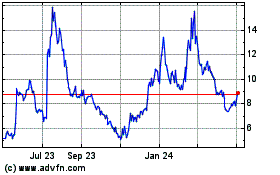Recursion (Nasdaq: RXRX) reported 12 month data from the Phase 2
study (SYCAMORE) of REC-994, the first industry sponsored Phase 2
trial completed in Cerebral Cavernous Malformations (CCM). The
Company announced in September 2024 that the signal-finding study
met its primary endpoint.
These results were presented today at the Late-Breaking Science
Concurrent Oral Abstract Sessions at the International Stroke
Conference (ISC) in Los Angeles, CA. Recursion will also hold a
webinar on Thursday, February 6th at 6:30am MT/8:30am ET/1:30pm GMT
to present the Phase 2 data. The webinar will be broadcast from
Recursion’s X (formerly Twitter), LinkedIn, and YouTube accounts
with an opportunity to submit questions here. The full presentation
can be accessed after the webinar on Recursion’s events &
presentation page.
"The results of the SYCAMORE trial demonstrate safety of REC-994
for CCM patients and promising trends of efficacy including 50% of
patients achieving a reduction in mean lesion volume after 12
months of treatment and improved functional outcome as assessed by
mRS at the 400 mg dose. My co-investigators and I are encouraged by
these initial findings and we look forward to continued work with
Recursion on the REC-994 program,” said Dr. Jan-Karl Burkhardt, MD,
Division Head, Cerebrovascular Surgery, University of Pennsylvania
and Principal Investigator of the study.
“We are pleased to share the updated Phase 2 data through a
late-breaking oral presentation at this year’s International Stroke
Conference. These preliminary results show promising MRI-based and
functional outcome signals, and we look forward to continued
discussions with the FDA, and the CCM scientific and patient
communities on next steps," said Najat Khan, Ph.D., Chief R&D
Officer and Chief Commercial Officer of Recursion.
As the first industry-initiated trial
in CCM, the SYCAMORE study was designed to evaluate safety as well
as efficacy signals with broad patient populations. The trial was
not powered to demonstrate statistical difference against placebo,
and patients were not stratified or enriched across dose
levels.
REC-994 SYCAMORE Phase 2 Trial
Results
Safety & Tolerability
(primary endpoint)
- No safety signals observed, with incidence of adverse events
comparable between treatment and placebo arms
- Most common adverse events reported in at least 10% of
participants included: Covid-19, dizziness, headache, back pain,
and constipation
- No SAEs related to study drug
- Majority of TEAEs were Grade 1-2
- No treatment-related adverse events that led to
discontinuations
Select Secondary &
Exploratory Analyses
- Total Cerebral Lesion Volume
- After 12 months of treatment, 50% of patients on REC-994 400 mg
(N=20) demonstrated reduction in total lesion volume (LV) versus
28% observed in placebo (N=18) . Patients on REC-994 200 mg (N=17)
had similar changes in lesion volume compared to placebo
- An absolute mean decrease in total lesion volume of −457 mm3
was observed in the 400 mg arm vs. an absolute mean increase of 61
mm3 and 53 mm3 in the 200 mg and placebo arms, respectively
- Modified Rankin Scale (mRS) scores
- The modified Rankin Scale (mRS) is widely recognized and
approved by the FDA as a clinically meaningful endpoint for
assessing functional outcomes in acute stroke trials. A single
point change on the mRS is clinically relevant, with precedent for
the FDA accepting dichotomous approaches using mRS cutoffs
- At baseline, patients on REC-994 400 mg had a greater
proportion of mRS scores ≥ 3, including an mRS score of 4-5,
indicating that at the start of study these patients had worse
clinical function versus the placebo arm
- After 12 months of treatment, patients on REC-994 400 mg
demonstrated trends toward improvement and/or stabilization of
symptoms versus the placebo arm, which observed trends towards
functional decline
- Brainstem Cohort
- Similar trends in lesion volume reduction and improvement or
stabilization as assessed by mRS in the 400 mg REC-994 arm were
seen in patients with brainstem lesions
- These observations support further investigation in a
population of high unmet need, as cavernomas located in the
brainstem are not amenable to surgical intervention
Additional secondary and
exploratory analyses
- Time-dependent reductions in hemosiderin ring size observed in
the 400 mg arm as compared to 200 mg and placebo
- Seizure frequency appeared to be reduced in the 400 mg arm as
compared to 200 mg and placebo however, there was imbalance with
respect to seizure history and frequency across the arms
- Incidence of new symptomatic hemorrhage events were comparable
across arms and in line with natural history studies
- Other PROs including PROMIS29, CCM-HI, NIHSS, SMSS, CGI, and
PGI did not demonstrate differences between the treatment arms of
the study nor placebo
Next steps
Recursion intends to submit these data
for publication in a peer reviewed scientific journal. Next steps
will be guided by regulatory discussions and on-going long term
extension study.
About REC-994
REC-994 is an orally bioavailable, superoxide scavenger small
molecule under development for the treatment of symptomatic CCM.
The potential of REC-994 in CCM was demonstrated using the earliest
version of what would become the foundational technology underlying
the Recursion OS. Subsequently, REC-994 demonstrated preclinical
activity in models for CCM and tolerability and suitability for
chronic dosing in Phase 1 single ascending dose escalation (SAD)
and multiple ascending dose escalation (MAD) trials in healthy
volunteers directed and executed by Recursion. Recursion received
Orphan Drug Designation for REC-994 in symptomatic CCM in the US
and Europe.
About the SYCAMORE Trial
Our Phase 2 SYCAMORE clinical trial is a randomized,
double-blind, placebo-controlled study of two doses (200 mg and 400
mg) of REC-994 in participants with CCM. The primary endpoint of
the study is safety and tolerability. Secondary efficacy endpoints
include MRI-based endpoints, clinician and patient reported
outcomes, as well as selected biomarkers. This trial was fully
enrolled in June 2023 with 62 participants, and 80% of participants
who completed 12 months of treatment have entered the long-term
extension study. This signal-finding study was not powered to
demonstrate statistical significance.
About RecursionRecursion (NASDAQ: RXRX) is a
clinical stage TechBio company leading the space by decoding
biology to radically improve lives. Enabling its mission is the
Recursion OS, a platform built across diverse technologies that
continuously generate one of the world’s largest proprietary
biological and chemical datasets. Recursion leverages sophisticated
machine-learning algorithms to distill from its dataset a
collection of trillions of searchable relationships across biology
and chemistry unconstrained by human bias. By commanding massive
experimental scale — up to millions of wet lab experiments weekly —
and massive computational scale — owning and operating one of the
most powerful supercomputers in the world, Recursion is uniting
technology, biology and chemistry to advance the future of
medicine.
Recursion is headquartered in Salt Lake City, where it is a
founding member of BioHive, the Utah life sciences industry
collective. Recursion also has offices in Toronto, Montréal, New
York, London, Oxford area, and the San Francisco Bay area. Learn
more at www.Recursion.com, or connect on X (formerly Twitter) and
LinkedIn.
Media ContactMedia@Recursion.com
Investor ContactInvestor@Recursion.com
Forward-Looking Statements
This document contains information that includes or is based
upon “forward-looking statements” within the meaning of the
Securities Litigation Reform Act of 1995, including, without
limitation, those regarding the clinical relevance of the SYCAMORE
trial data and obtaining additional confirmatory data; promising
trends in REC-994 efficacy endpoints; Recursion’s plans to submit
SYCAMORE trial data for publication in a peer-reviewed journal;
advancing potential transformational therapies for CCM and beyond;
subsequent REC-994 studies and their results and advancing
Recursion’s REC-994 program further; the size of the potential CCM
patient population; Recursion OS and other technologies; business
and financial plans and performance; and all other statements that
are not historical facts. Forward-looking statements may or may not
include identifying words such as “plan,” “will,” “expect,”
“anticipate,” “intend,” “believe,” “potential,” “continue,” and
similar terms. These statements are subject to known or unknown
risks and uncertainties that could cause actual results to differ
materially from those expressed or implied in such statements,
including but not limited to: challenges inherent in pharmaceutical
research and development, including the timing and results of
preclinical and clinical programs, where the risk of failure is
high and failure can occur at any stage prior to or after
regulatory approval due to lack of sufficient efficacy, safety
considerations, or other factors; our ability to leverage and
enhance our drug discovery platform; our ability to obtain
financing for development activities and other corporate purposes;
the success of our collaboration activities; our ability to obtain
regulatory approval of, and ultimately commercialize, drug
candidates; our ability to obtain, maintain, and enforce
intellectual property protections; cyberattacks or other
disruptions to our technology systems; our ability to attract,
motivate, and retain key employees and manage our growth; inflation
and other macroeconomic issues; and other risks and uncertainties
such as those described under the heading “Risk Factors” in our
filings with the U.S. Securities and Exchange Commission, including
our Annual Report on Form 10-K and Quarterly Reports on Form 10-Q.
All forward-looking statements are based on management’s current
estimates, projections, and assumptions, and Recursion undertakes
no obligation to correct or update any such statements, whether as
a result of new information, future developments, or otherwise,
except to the extent required by applicable law.
Photos accompanying this announcement are available at:
https://www.globenewswire.com/NewsRoom/AttachmentNg/d81f369a-3622-4ffc-b298-a2a3a31047a0
https://www.globenewswire.com/NewsRoom/AttachmentNg/b4285139-1d7e-42e3-95d8-a12bc8ea58a8
https://www.globenewswire.com/NewsRoom/AttachmentNg/8090c106-c7e6-416f-9060-c16ee5bb53ee
Recursion Pharmaceuticals (NASDAQ:RXRX)
Historical Stock Chart
From Jan 2025 to Feb 2025

Recursion Pharmaceuticals (NASDAQ:RXRX)
Historical Stock Chart
From Feb 2024 to Feb 2025
